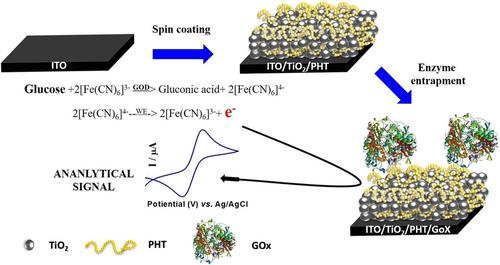当前位置:
X-MOL 学术
›
Electroanalysis
›
论文详情
Our official English website, www.x-mol.net, welcomes your feedback! (Note: you will need to create a separate account there.)
Synthesis and Application of PHT‐TiO2 Nanohybrid for Amperometric Glucose Detection in Human Saliva Sample
Electroanalysis ( IF 3 ) Pub Date : 2018-09-27 , DOI: 10.1002/elan.201800207 Sachin Kadian 1, 2 , Brahm Dutt Arya 1 , Sumit Kumar 1 , Shailesh N. Sharma 1 , Rishi Pal Chauhan 2 , Ananya Srivastava 3 , Pranjal Chandra 4 , Surinder P. Singh 1
Electroanalysis ( IF 3 ) Pub Date : 2018-09-27 , DOI: 10.1002/elan.201800207 Sachin Kadian 1, 2 , Brahm Dutt Arya 1 , Sumit Kumar 1 , Shailesh N. Sharma 1 , Rishi Pal Chauhan 2 , Ananya Srivastava 3 , Pranjal Chandra 4 , Surinder P. Singh 1
Affiliation

|
Nanoparticles and their composites are considered to play a significant role in the development of electrochemical biosensors. In the present work, we have synthesized titanium dioxide (TiO2) nanoparticles comprising poly (3‐hexylthiophene) (PHT) nanohybrid for the fabrication of glucose biosensor. The thin film of hybrid PHT/TiO2 nano‐composite was deposited onto indium‐tin‐oxide (ITO) glass substrate followed by immobilization of glucose oxidase (GOx). The developed sensor was characterized using X‐Ray Diffraction, Fourier Transform Infrared Spectroscopy, UV‐visible spectroscopy, cyclic voltammetry, electrochemical impedance spectroscopy, and scanning electron microscopy. The electrochemical response of the nanocomposite coated electrode was studied which shows a quasi‐reversible electrochemical behavior. The experimental conditions for glucose detection were optimized in terms of GOx immobilization time, GOx concentrations, temperature, and pH, in order to obtain maximum sensitivity. Under the optimized experimental conditions, the ITO/TiO2/PHT/GOx sensor probe displays excellent catalytic activity towards glucose with the response time of <10.0 sec, showing its robustness for direct clinical analysis. Chronoamperometry was performed for the quantitative detection of glucose which displays the linear dynamic range between 1–310 mg/dL with the detection limit of 0.62±0.02 mg/dL. The developed biosensor was successfully applied to detect glucose in human saliva samples without any pre‐treatment step. Importantly, the detection range of the designed biosensor was in range of normal and clinical salivary glucose levels. Interferences due to nontarget biochemicals was investigated and long term stability of the sensor probe was evaluated.
中文翻译:

PHT-TiO2纳米杂合物的合成及其在人唾液中安培葡萄糖检测中的应用
纳米颗粒及其复合物被认为在电化学生物传感器的发展中起着重要作用。在目前的工作中,我们已经合成了包含聚(3-己基噻吩)(PHT)纳米杂化物的二氧化钛(TiO 2)纳米粒子,用于制造葡萄糖生物传感器。PHT / TiO 2杂化薄膜将纳米复合材料沉积在氧化铟锡(ITO)玻璃基板上,然后固定葡萄糖氧化酶(GOx)。使用X射线衍射,傅立叶变换红外光谱,紫外可见光谱,循环伏安法,电化学阻抗谱和扫描电子显微镜对已开发的传感器进行了表征。研究了纳米复合涂层电极的电化学响应,显示出准可逆的电化学行为。为了获得最大的灵敏度,根据GOx固定时间,GOx浓度,温度和pH对葡萄糖检测的实验条件进行了优化。在优化的实验条件下,ITO / TiO 2/ PHT / GOx传感器探针对葡萄糖表现出出色的催化活性,响应时间<10.0秒,显示了其对直接临床分析的鲁棒性。用计时安培法对葡萄糖进行定量检测,其线性动态范围在1–310 mg / dL之间,检出限为0.62±0.02 mg / dL。无需任何预处理步骤,开发出的生物传感器就可以成功地用于检测人唾液样本中的葡萄糖。重要的是,设计的生物传感器的检测范围在正常和临床唾液葡萄糖水平的范围内。研究了由于非目标生物化学物质引起的干扰,并评估了传感器探针的长期稳定性。
更新日期:2018-09-27
中文翻译:

PHT-TiO2纳米杂合物的合成及其在人唾液中安培葡萄糖检测中的应用
纳米颗粒及其复合物被认为在电化学生物传感器的发展中起着重要作用。在目前的工作中,我们已经合成了包含聚(3-己基噻吩)(PHT)纳米杂化物的二氧化钛(TiO 2)纳米粒子,用于制造葡萄糖生物传感器。PHT / TiO 2杂化薄膜将纳米复合材料沉积在氧化铟锡(ITO)玻璃基板上,然后固定葡萄糖氧化酶(GOx)。使用X射线衍射,傅立叶变换红外光谱,紫外可见光谱,循环伏安法,电化学阻抗谱和扫描电子显微镜对已开发的传感器进行了表征。研究了纳米复合涂层电极的电化学响应,显示出准可逆的电化学行为。为了获得最大的灵敏度,根据GOx固定时间,GOx浓度,温度和pH对葡萄糖检测的实验条件进行了优化。在优化的实验条件下,ITO / TiO 2/ PHT / GOx传感器探针对葡萄糖表现出出色的催化活性,响应时间<10.0秒,显示了其对直接临床分析的鲁棒性。用计时安培法对葡萄糖进行定量检测,其线性动态范围在1–310 mg / dL之间,检出限为0.62±0.02 mg / dL。无需任何预处理步骤,开发出的生物传感器就可以成功地用于检测人唾液样本中的葡萄糖。重要的是,设计的生物传感器的检测范围在正常和临床唾液葡萄糖水平的范围内。研究了由于非目标生物化学物质引起的干扰,并评估了传感器探针的长期稳定性。


























 京公网安备 11010802027423号
京公网安备 11010802027423号